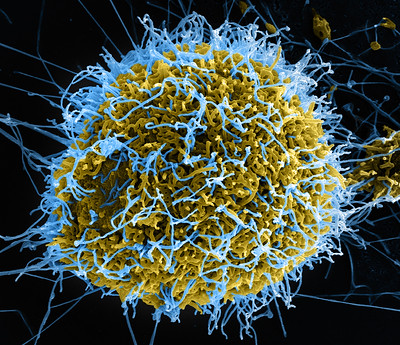Recent Resurgence of Ebola Virus
Recent Resurgence of Ebola Virus
October 25, 2021
The COVID-19 pandemic negatively impacted the epidemiological control of several infectious diseases worldwide. Specifically, Ebola virus disease has been sporadically resurging in Guinea and the Democratic Republic of the Congo (DRC) in 2021. A total of 16 confirmed and 7 probable cases were reported, of whom 12 people died in Guinea (1). Eleven confirmed cases and one probable case, six deaths and six recoveries were recorded in DRC (2). The coexistence of both outbreaks increased the burden on the country’s health system mainly because Ebola response programs were redirected to the COVID-19 national response (3, 4). The imposition of strict lockdowns threatened Ebola control activities, leading to inefficient Ebola surveillance and contact tracing. Importantly, genome sequencing analyses indicated that these Ebola outbreaks were sparked by the transmission of the virus from the survivors from previous epidemics, the 2013-2016 outbreak (Guinea) (5) and 2018–2020 outbreak (DRC) (6). These underline the risk for reemergence of the virus after interruption of active transmission.
 Connections to the 2013-2016 Outbreak
Connections to the 2013-2016 Outbreak
From December 2013 to June 2016, Sierra Leone, Guinea and Liberia experienced an Ebola virus outbreak causing 28,646 confirmed, probable, and suspected Ebola virus disease cases—including 11,323 deaths and over 10,000 survivors (7). A recent publication clearly demonstrated the role of survivors in new outbreak. During the 2021 outbreaks, the samples taken from the 12 different patients were subjected to next-generation sequencing (NGS) analysis, leading to the generation of complete or near-complete genomes of Zaire ebolavirus (5). These genomes form a well-supported phylogenetic cluster with genomes from the previous outbreak. They also share 10 substitutions (compared with KJ660346) that were accumulated during the 2013–2016 outbreak, including the A82V marker mutation for human adaptation in the glycoprotein that arose when the virus spread to Sierra Leone. These patterns provide strong evidence of a direct link to human cases from the 2013–2016 outbreak rather than the result of a new spillover event from an animal reservoir. This further indicates a persistent infection with reduced replication of the virus or a period of latency.
Persistence of Ebola Virus
After acute infection, persistence of Ebola virus in survivors has been found in immunologically privileged sites, such as the testes, interior of the eyes, placenta, and central nervous system (i.e., cerebrospinal fluid), where the infected cell has limited exposure to memory T cells (8, 9). This permits the virus to proliferate unchecked or partially checked (low grade chronic inflammation). This might explain the random recurrence of disease in these tissues, since the balance between low level immune cell surveillance and low level viral replication will be constantly shifting (9). Specifically, a cohort study from May 2015 to April 2017 in Sierra Leone showed the persistence of Ebola viral RNA in semen during post-recovery (10). Among participants with both severe acute Ebola virus disease and a higher age (>35 years), persistence remained above 20% at 1 year. However, the duration of Ebola virus in survivors has not been well characterized. Strikingly, the finding of resurgence of Zaire ebolavirus in Guinea suggests the transmission of the virus from human to human five years after the end of the previous outbreak.
Importantly, genome sequencing analyses indicated that these Ebola outbreaks were sparked by the transmission of the virus from the survivors from previous epidemics, the 2013-2016 outbreak (Guinea) (5) and 2018–2020 outbreak (DRC) (6).
Strikingly, the finding of resurgence of Zaire ebolavirus in Guinea suggests the transmission of the virus from human to human five years after the end of the previous outbreak.
Since the two largest outbreaks of Ebola virus disease in Guinea and DRC, much progress has been made to effectively mitigate the disease. In response to the outbreaks, these countries have demonstrated the capability and infrastructure to effectively identify the cause of outbreak, which can help curtail the chain of viral transmission.
 Conclusion
Conclusion
Since the two largest outbreaks of Ebola virus disease in Guinea and DRC, much progress has been made to effectively mitigate the disease. In response to the outbreaks, these countries have demonstrated the capability and infrastructure to effectively identify the cause of outbreak, which can help curtail the chain of viral transmission. Furthermore, this confirmation has facilitated the application of recently available monoclonal antibody therapeutics (i.e., Inmazeb and Ebanga) and vaccines (i.e., Ervebo and Zabdeno-Mvabea). In particular, available vaccines have shown to be effective against Zaire ebolavirus. However, vaccines have been mostly used in response to outbreaks (11). The recent resurgence of Ebola virus disease requires an effective response strategy, including widespread routine vaccination of healthcare, frontline workers, survivors, and other high-risk groups throughout endemic areas for Ebola virus disease. It will be also important to understand the long-term effects of Ebola virus infection, including viral persistence, and to implement preventive strategies, such as efficient treatment, care, and education to the survivors and systemic and continued surveillance of the virus.
Our GVN team thanks Dr. Robert Garry (Tulane University School of Medicine) for reviewing this manuscript and for providing us with invaluable comments and insights.
References
- Ebola outbreak 2021- N’Zerekore, Guinea. https://www.who.int/emergencies/situations/ebola-2021-nzerekore-guinea
- Ebola outbreak 2021- North Kivu. https://www.who.int/emergencies/situations/ebola-2021-north-kivu
- The double burden of coronavirus and Ebola in eastern DRC. 2021. https://www.devex.com/news/the-double-burden-of-coronavirus-and-ebola-in-eastern-drc-97189.
- Médecins Sans Frontières. DRC tenth Ebola outbreak. 2021. https://www.msf.org/drc-tenth-ebola-outbreak.
- Keita AK, Koundouno FR, Faye M, Düx A, Hinzmann J, et al. Resurgence of Ebola virus in 2021 in Guinea suggests a new paradigm for outbreaks. Nature. 2021 Sep;597(7877):539-543. doi: 10.1038/s41586-021-03901-9. Epub 2021 Sep 15. PMID: 34526718.
- Khan FMA, Hasan MM, Kazmi Z, Dos Santos Costa AC, Aborode AT, Ahmad S, Essar MY. Ebola and COVID-19 in Democratic Republic of Congo: grappling with two plagues at once. Trop Med Health. 2021 Aug 24;49(1):67. doi: 10.1186/s41182-021-00356-6.
- WHO (2016a). Ebola Situation Report – March 30, 2016. http://apps.who.int/ebola/current-situation/ebola-situation-report-30-march-2016.
- Racine, T., Kobinger, G. Viral pathogenesis: Unlocking Ebola persistence. Nat Microbiol2, 17124 (2017). https://doi.org/10.1038/nmicrobiol.2017.124
- Forrester JV. Ebola virus and persistent chronic infection: when does replication cease? Ann Transl Med. 2018 Nov;6(Suppl 1):S39. doi: 10.21037/atm.2018.09.60. PMID: 30613614; PMCID: PMC6291550.
- Thorson AE, Deen GF, Bernstein KT, Liu WJ, Yamba F, et al. Sierra Leone Ebola Virus Persistence Study Group. Persistence of Ebola virus in semen among Ebola virus disease survivors in Sierra Leone: A cohort study of frequency, duration, and risk factors. PLoS Med. 2021 Feb 10;18(2):e1003273. doi: 10.1371/journal.pmed.1003273.
- Bausch, D.G. The need for a new strategy for Ebola vaccination. Nat Med27, 580–581 (2021). https://doi.org/10.1038/s41591-021-01313-w.
